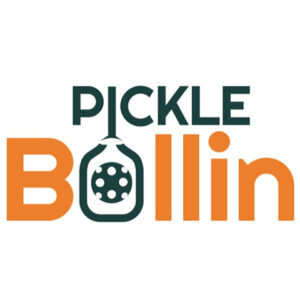Pickleball is a paddle ball/racquet sport that is quickly rising in popularity. The pickleball game can consist of two to four people, and there are specific requirements for the court. Today, we’re going to discuss pickleball court dimensions. We’ll discuss what size the court should be, the different areas of the court that have to be marked, and the types of things you will need to use for your own pickleball court.
You’ll learn everything you need to know to create your regulation-sized pickleball court. We use the size recommended by the official United States of America Pickleball Association.
If you’re looking for a beginner’s guide on pickleball check out, Pickleball Strategy: Complete Beginner’s Guide!
The History Behind Pickleball
In 1965, while enjoying a relaxing game of golf, Washington State Congressman Joel Pritchard, alongside business executive Bill Bell, found themselves with little to do for the afternoon. Pritchard’s property features a decrepit badminton court, but the two could not find equipment to play. Instead, they improvised. Both men donned ping pong paddles, and a wiffle ball then lowered the net on the court. Thus, the game of pickleball was invented.
In 1967, the first official pickleball court was built on Pritchard’s property. In 1972, they built an organization to protect the sport. Each year since, the sport has grown. By 1990, folks in over 50 states enjoyed pickleball. Today, USA Pickleball aims to host national championships and align themselves with other US sports franchises.
Court Dimensions
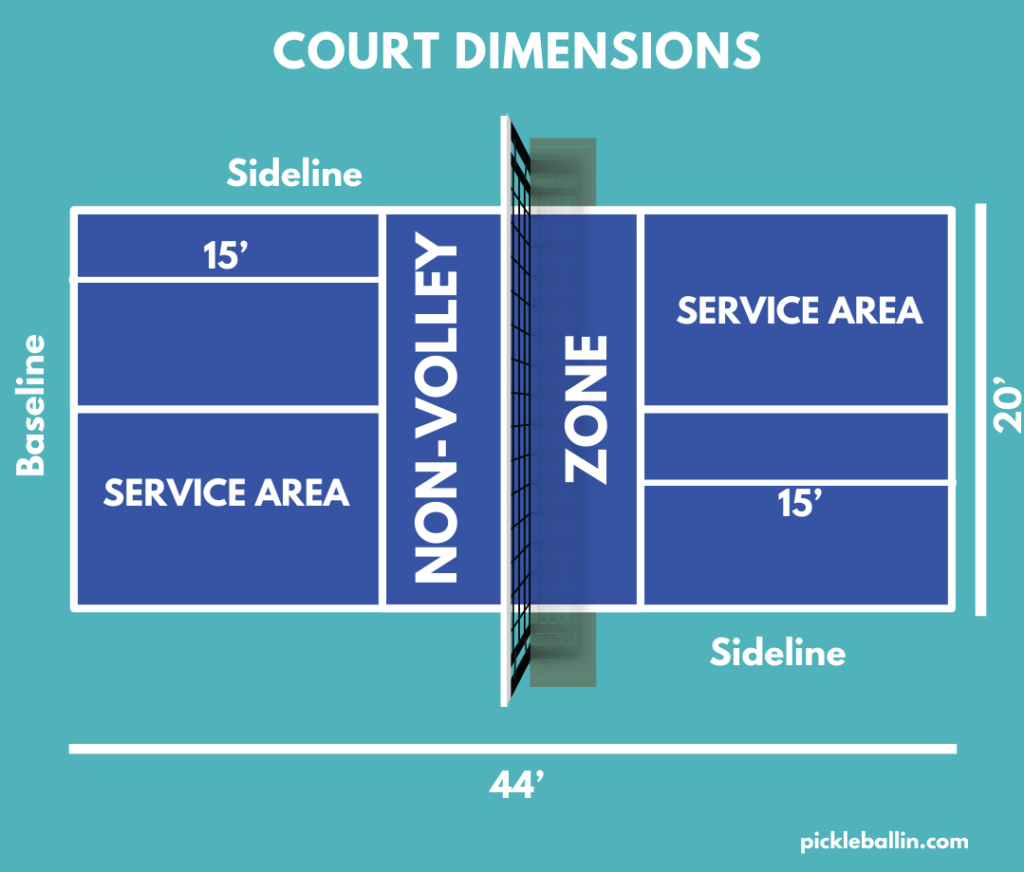
The sport of pickleball has specific regulations regarding the size of the court. If you want to design a pickleball court, you’ll need to ensure proper pickleball court measurements. Improperly sized courts can be ineligible for playing pickleball.
Pickleball Court Terms
To help you understand the pickleball court dimensions in the previous graphic we’ll describe the pickleball court terms below! Be sure to review and familiarize yourself with these five pickleball court terms in order to have a better understanding of the court’s playing area, no-play zones, and court lines.
Baseline: The baseline runs parallel to the net at the back of the court. The baseline can’t be crossed when you serve.
Centerline: The centerline extends from the kitchen to the baseline and divides the court into two equal halves.
Kitchen: The kitchen is the nickname for the non-volley zone that extends 7 feet on either side of the net.
Non-Volley Zone: The non-volley zone also known as the no volley zone is the area within seven feet on both sides of the net where volleying is not allowed. One of the best places to position yourself is right behind the non-volley zone. The net will limit the number of angles at which your opponent can hit at you.
Service Courts: The service courts are the areas on either side of the centerline, bounded by the non-volley line, the baseline, and the sideline.
Sideline: The sideline runs perpendicular to the net on either side of the court. The sideline separates in-bounds from out-of-bounds.
Playing Court
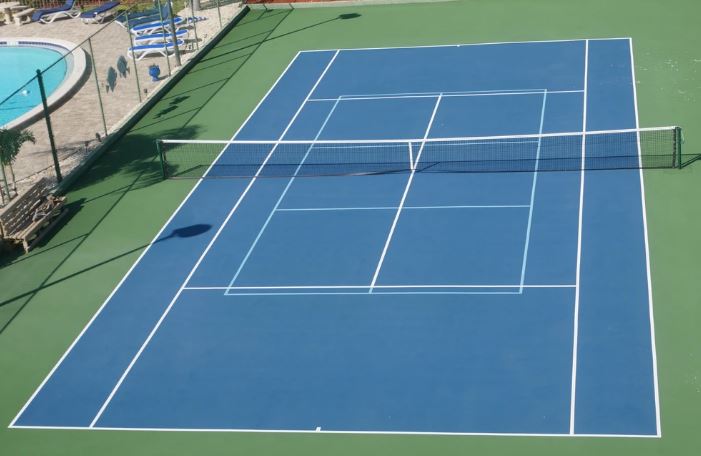
According to the USAPA (United States of America Pickleball Association), a regulation size pickleball court has to be a rectangle that’s 20 feet wide and 44 feet long, which is the same size as a badminton court.
This size court allows for single teams (2 players going against each other) or for groups of two (four people total – 2 per side).
Pickleball may have the same size court as badminton, but the net requirements are different. The pickleball game requires the net to be lower, at 36 inches on the ends, and 34 inches at the center.
Outer Zones
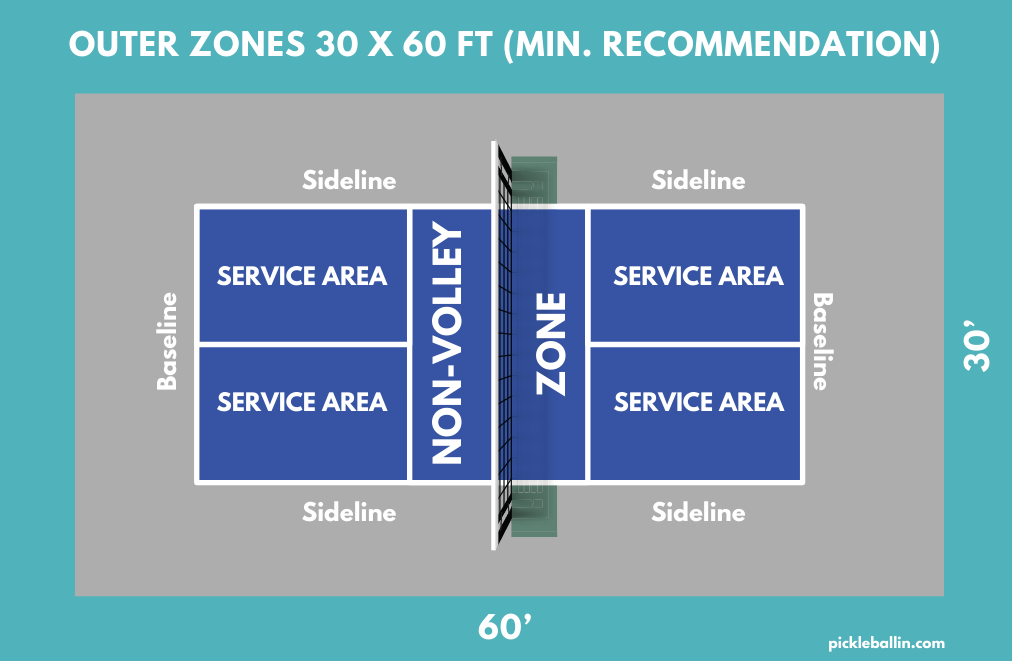
In addition to the court size for gameplay, it is also a recommendation that you provide adequate room for the out-of-bounds area.
The pickleball court size should be 24 feet wide by 54 feet long, including the sidelines and end courts (all out of bound areas).
If possible, a court that is 30 feet long by 60 feet wide is the best outcome. This size would provide enough room for the players to move around and prevent damage from missed or wild balls.
It’s also a recommendation that you add a 10-foot margin to your court’s measurement, possibly expanding the court size to 40 feet by 64 feet. But this isn’t a requirement for regulation size courts when there is limited space.
How to Measure Out Pickleball Court Dimensions
When measuring out the pickleball court dimensions, points should go to outside of the perimeter and non volley zone lines (NVZ).
The non volley zone has three boundary lines surrounding the net. The boundaries for the NVZ should be one parallel line seven feet from the net. The two sidelines are perpendicular to the net but inside the NVZ.
Lines
Once you have your court measured out and set up, you have to draw out the pickleball lines. There are different lines for specific areas of the court. Precise and accurate measurements are necessary to have a regulation court.
The different court dimension lines are:
- Baselines
- Sidelines
- Non volley zone
- Centerline
- Service court
Baseline
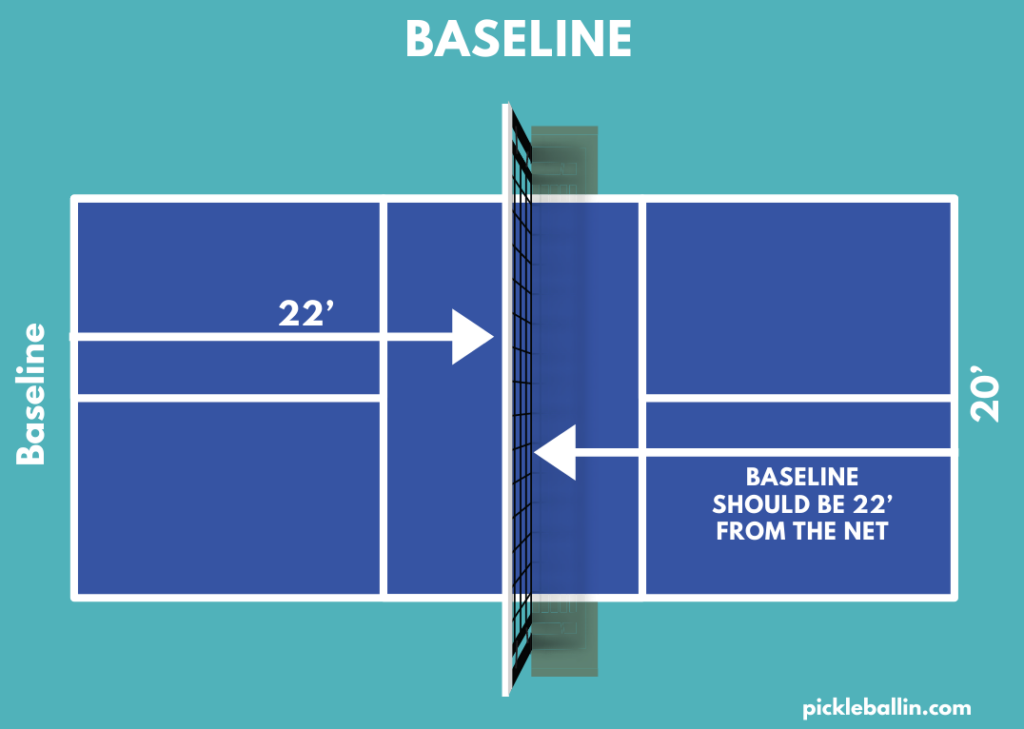
The baseline has to be 22 feet from the net. All lines should be 2″ wide and painted with a contrasting color to the court, so the lines are noticeable and visible.
This line should be drawn at the back of the pickleball court, on both sides of the court. Remember that it needs to be parallel to the net but 22 feet away. The baseline creates the back end of the court.
Sidelines

The sidelines are the lines that run along the sides of the court to create the playing zone. Once the ball passes the sidelines, it becomes out of bounds.
As with the baseline, the sidelines should be painted a contrasting color to the court, with 2″ wide lines. Use the same color for all the lines.
Non-Volley Zone
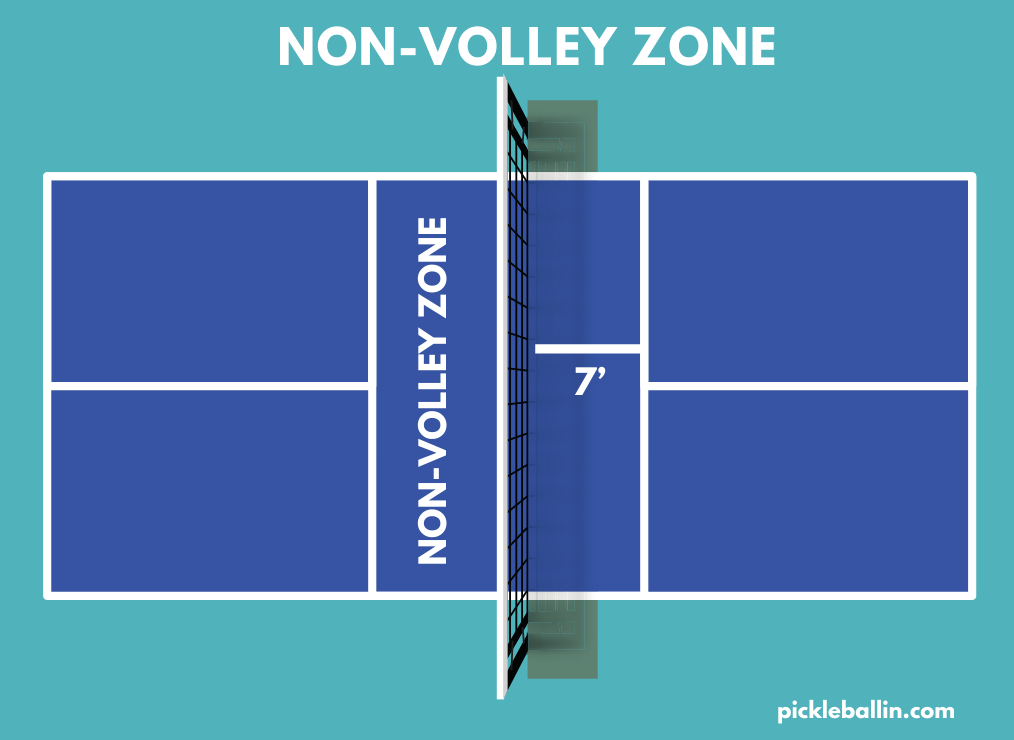
The non volley zone (NVZ) makes up the area between the net and the non-volley line, which is 7 feet from the net. You may hear this area referred to as the kitchen.
When the ball is in the NVZ, it cannot be hit. Therefore, you must have the non-volley zone marked, so the players don’t get penalized.
To set up the non volley zone, you will need to mark the area from the net to seven-foot past on both sides of the net using a contrasting color paint.
There will be lines on each side of the net, extending to each side of the court for two fourteen-foot lines.
Centerline
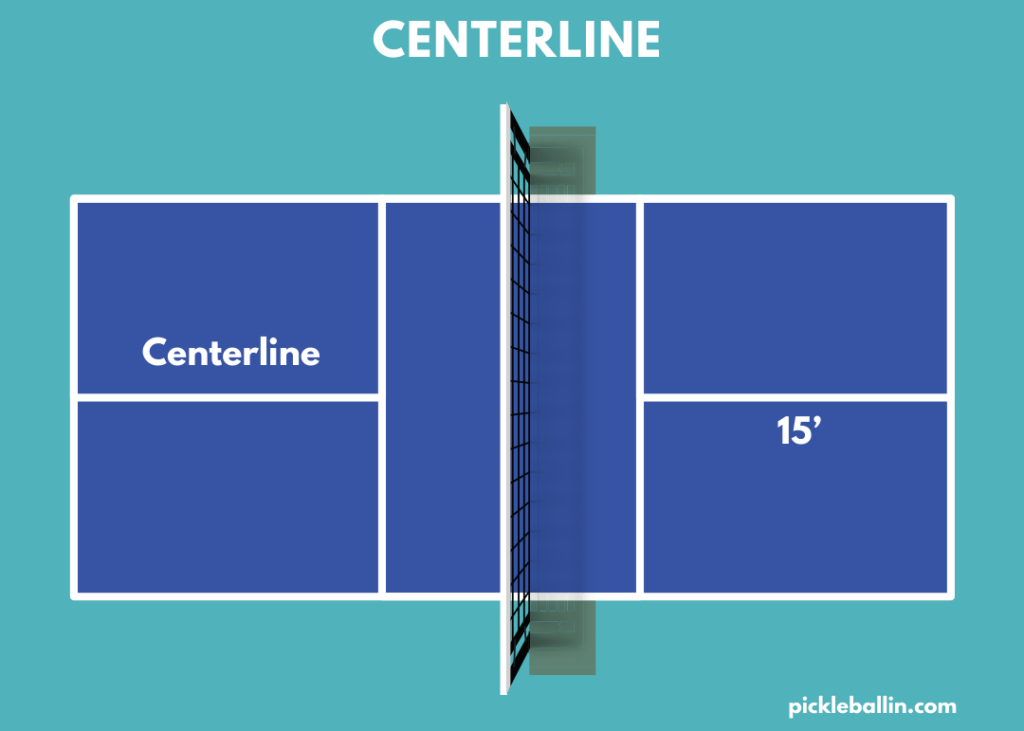
The centerline is the boundary that extends from the end of the non volley zone to the baseline. This line divides the player’s side of the court into two equal sides – odd and even.
When you lay the centerline, it needs to start at the end of the non-volley zone at the middle point of the line (15 feet). It will extend down the middle of each player’s court to the baseline at the back.
Service Court
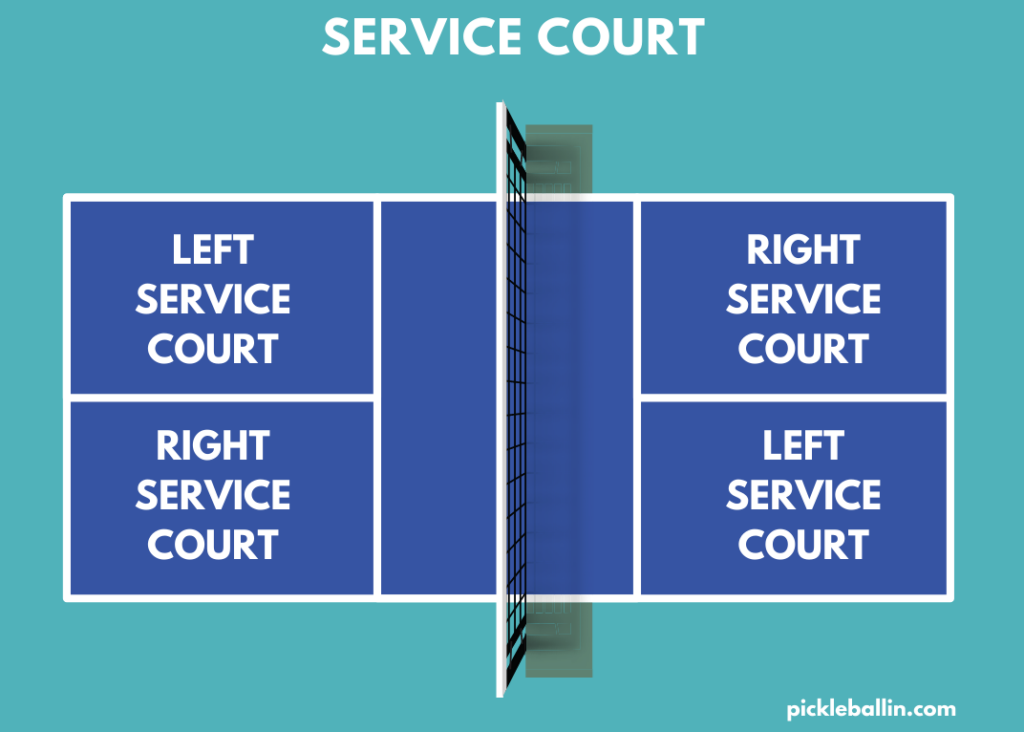
The service court is the area of the court that lies past the boundaries of the no-volley zone. This area consists of the centerline, sidelines, and baseline.
Each player has its own service court on its side of the court, which consists of the entire area court, except the NVZ.
The service area should consist of 10 feet wide and 15 feet long for each half of the player’s court (left and right should be equal).
Net Specifications
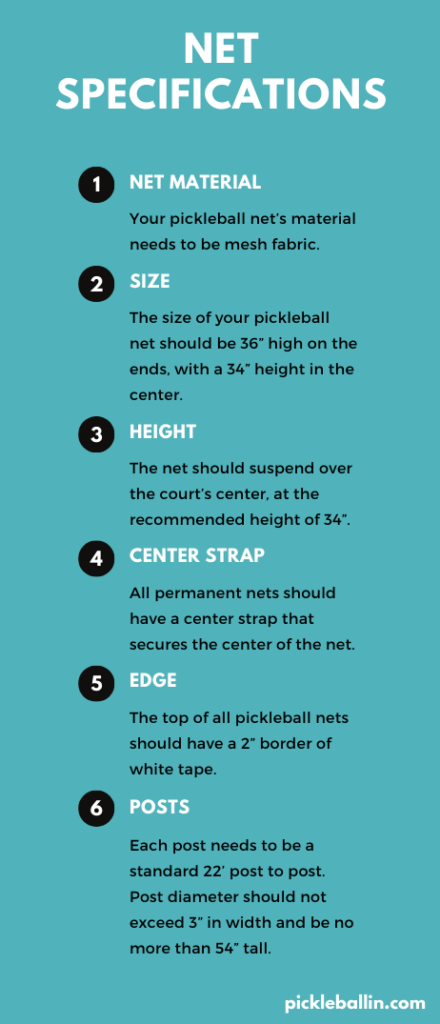
In addition to making sure your court has the proper size dimensions, you also need to make sure you have the correct net setup. Otherwise, your court will not pass regulations and will not be eligible for tournaments.
There are some general rules regarding the netting you must follow, including the size, material, and security features.
Net material
Your pickleball net’s material needs to be a mesh fabric that prevents the ball from passing through it. Many nets are made from synthetic fiber. For example, a tennis net is made with synthetic fiber. These nets are durable enough to withstand frequent use and weathering.
Netting that has holes in it like volleyball or tennis nets, is acceptable as a pickleball net, as long as the holes are not large enough for the pickleball to pass through the net.
Size
The size of a pickleball net should be 36″ high on the ends, with a 34″ height in the center. At a minimum, the net should be 30 inches. Any shorter and the net will not pass certification.
The length of a pickleball net should be 21’9″ (21 feet and 9 inches) from post to post. Each of the outer posts should extend past the sidelines, at least one foot.
Height
In pickleball, the net should suspend over the court’s center, at a recommended height of 34″ inches (30″ is the lowest height allowed).
On the end posts, the net should be at the height of 36″ and securely attached to the posts to ensure it doesn’t come loose during a match.
Center Strap
All permanent nets should have a center strap that secures the center of the net. This strap should be able to adjust to the 34″ height of the center net.
Edge
The top of all pickleball nets should have a 2″ border of white tape. This binding should cover a cord or cable that stretches along the top of the net. The binding must be on top of the chosen support.
Posts
Each post needs to be a standard 22 feet from post to post. Measurements should be from the inside of each post and not the outside.
Post diameter should not exceed 3″ in width (meaning how thick it is). The height should not be more than 54″ with no more than 1″ clearance above the net.
The net is a crucial piece of equipment, you can’t have a proper pickleball match without one! Other important pieces of equipment are shoes and paddles. There are so many options out there, we understand it can be difficult to find the best fit for you. We have put together some guides to help you, Best Pickleball Paddle and Best Pickleball Shoes
and Best Pickleball Shoes .
.
Pickleball Court Specifications Compared to Other Sports
To help you get a better understanding of the size of a pickleball court. Below we have put together visual comparisons of a pickleball court dimensions vs other sports court dimensions. You’ll find in a few of these comparisons, multiple pickleball courts can fit.
Pickleball Court vs Tennis Court
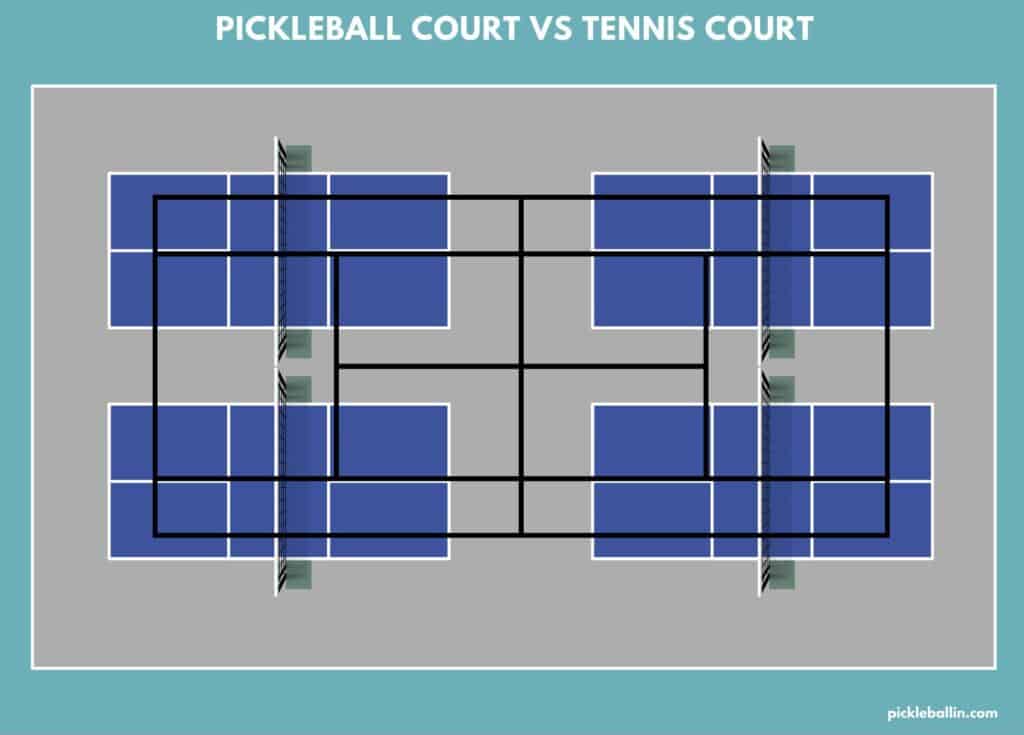
- Standard tennis court size is 36’ x 78’
- Recommended total play area is 60’ x 120’
- How many pickleball courts can fit: 4
Pickleball Court vs Volleyball Court
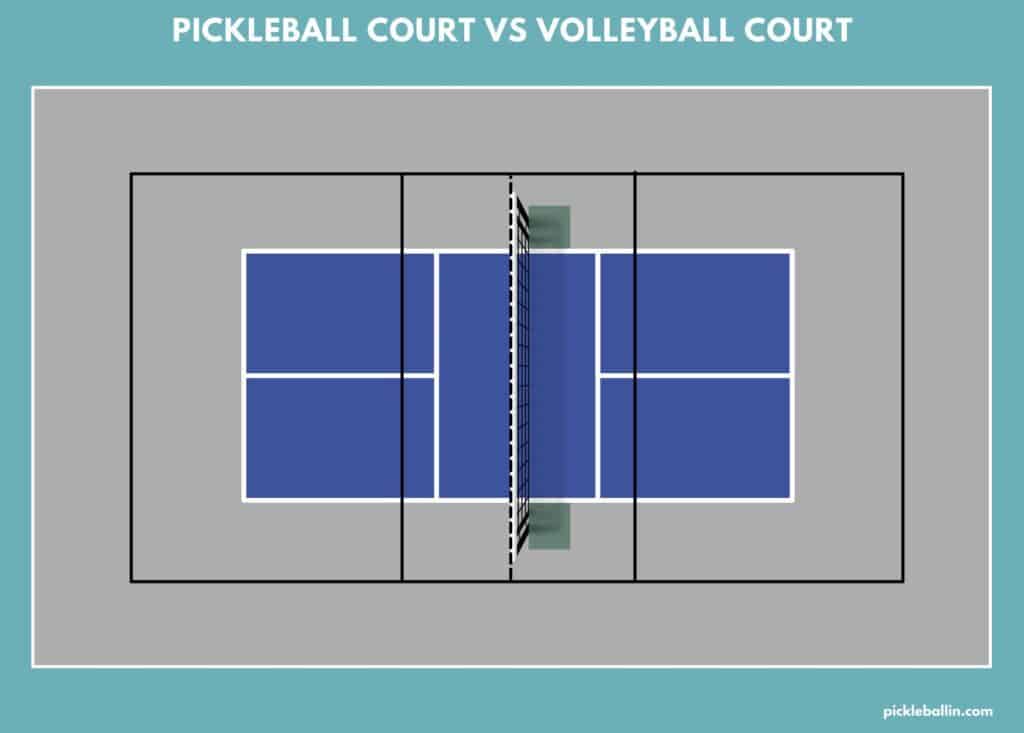
- Standard recreational volleyball court size is 29’ 6” x 59’
- The recommended total play area is 50’ x 80’
- How many pickleball courts fit: 1
Pickleball Court vs Basketball Court
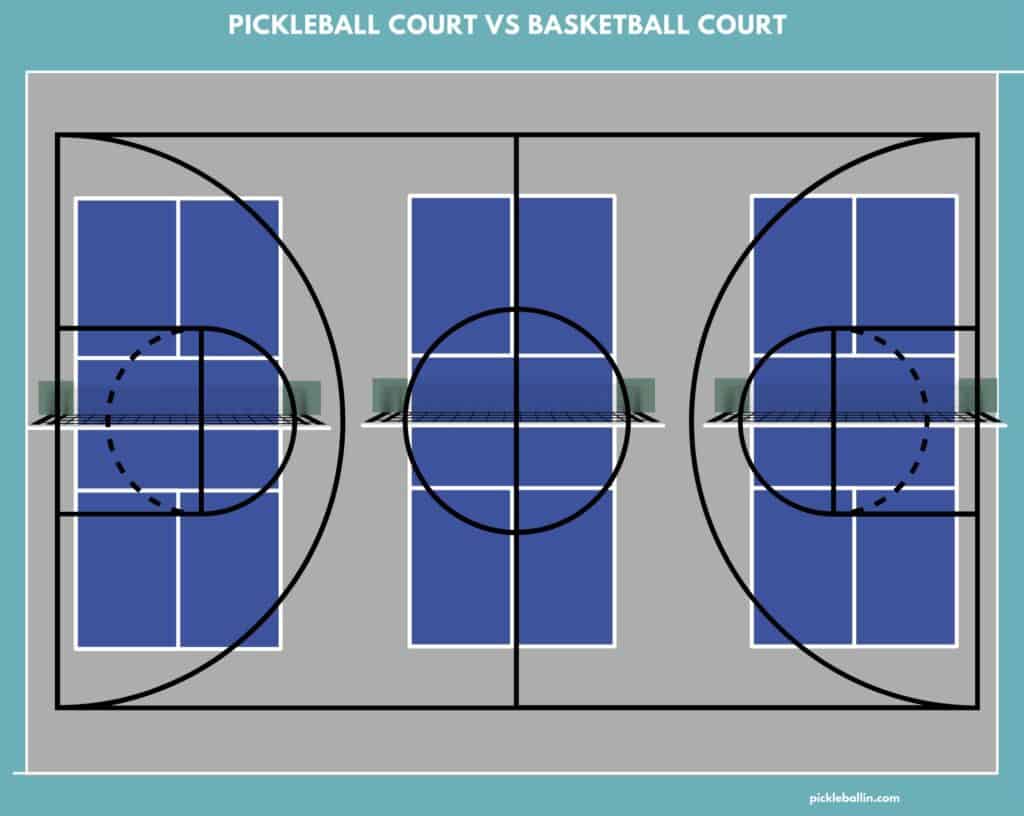
- Standard basketball court surface size is 50’ x 84’ (varies)
- The recommended total play area is 62’ x 96’ (varies)
- How many pickleball courts fit: 3
Pickleball Court vs Indoor Soccer Court
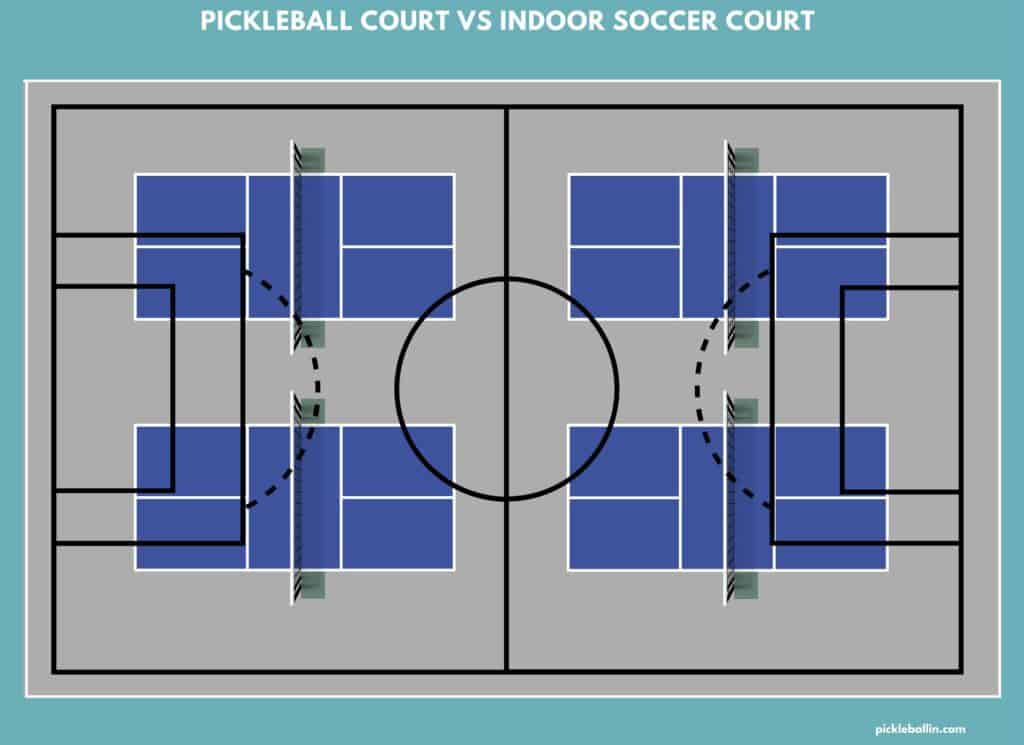
- Standard indoor soccer court size is 65’ x 131’ (varies)
- The recommended total play area is 81’ x 147’ (varies)
- How many pickleball courts fit: 4
Pickleball Court vs Ice Hockey Rink
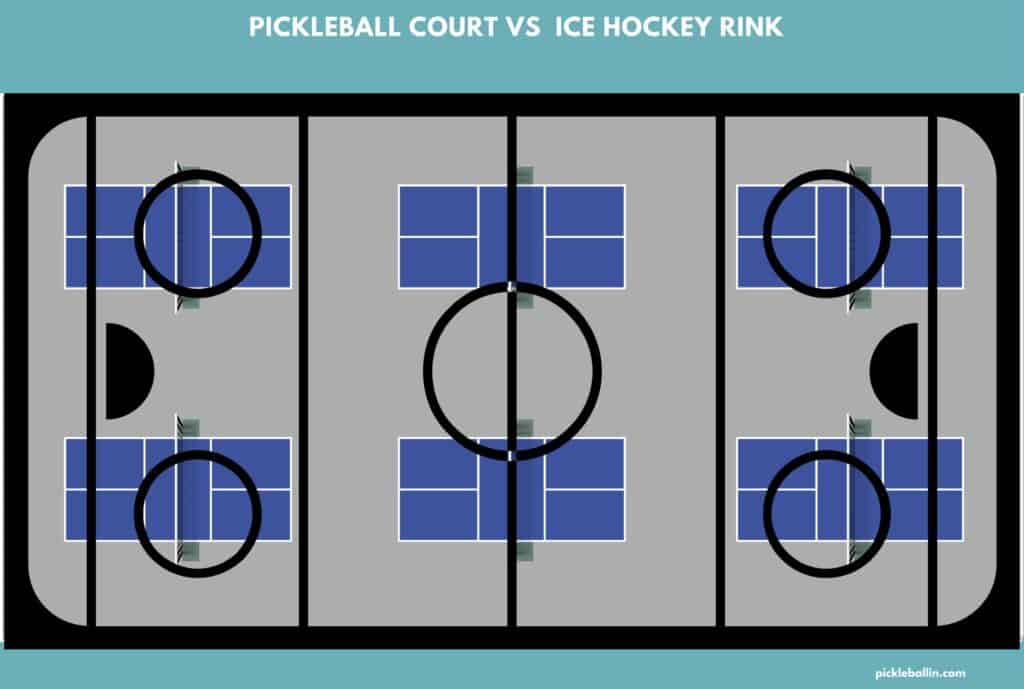
- Standard ice rink size is 85’ x 200’ (varies)
- The recommended total play area is 85’ x 200’ (varies)
- How many pickleball courts fit: 6
Building Your Own Pickleball Court
Are you looking to build a backyard pickleball court? If you really love pickleball but find it hard to make it to the courts or simply the courts are too far away, it may be a great option for you!
When you’re planning your playing surface, don’t forget to make sure you have every aspect covered. This starts with knowing the standard pickleball court specifications, then you choose your pickleball court surface. The court surface could be asphalt, concrete, or even plastic. You’ll also need to be able to layout the boundary lines, which should be 2 inches in width and in white paint only. It’s a good idea to find a decent fence, it will keep you from having to chase the ball too far. You’ll also need poles in place for the net, depending on what type of net you plan on installing. Nets can be both transportable or built-in. Whatever you choose, the poles should rest outside the sidelines of the court.
Thinking About Other Pickleball Equipment
If you’re new to pickleball and haven’t bought equipment or aren’t sure if the equipment you have is up to standards, I’ll quickly go over the equipment for the sport. Below, you’ll find actual guidelines for your paddles, balls, and even clothes.
Paddles
These are another piece of equipment that is regulated for pickleball, however, they’re not as regulated as pickleball court specifications are. Paddles are made from several different materials, some of the more common materials are wood, graphite, polycarbonate, and composite. It’s important that your pickleball paddle cannot have any kind of ridging, it needs to have a flat surface with a smooth texture. This is so players have an even playing field, ridging could allow a player the unfair advantage of adding more spin when hitting the ball. You have the freedom to choose the weight of your paddle as well as the color. Do keep in mind that there is a limit of how long your paddle can be. Paddles can be up to 17 inches long.
Pickleball Balls
Just like pickleball paddles, the pickleball ball also needs to be smooth. Unlike a tennis ball, pickleball balls cannot have any additional textures, to maintain the standards of the game. Additionally, pickleball balls have holes in them, the standard is each ball has a number of holes that range from 26 to 40 in total. The ball can be whatever color you like, however, they do need to be one single color. You can add small marks like initials or a small sticker for the purpose of identification. The majority of specifications for pickleball balls lie within the weight and measurement. When it comes to weight, the ball needs to be in the range of .78 and .935 ounces and the diameter needs to rest between 2.874 and 2.972 inches. It should also have a bounce of only between 30 to 34 inches.
Pickleball Attire
There really aren’t any rules that you need to worry about when it comes to clothing. You should find clothing that makes you comfortable and also provides protection. The main thing to follow is to make sure the clothing is appropriate. However, here are a couple of things you should keep in mind when dressing to play pickleball. Before choosing attire, consider where you’re playing. Are you playing on an outdoor pickleball court or an indoor one? Is it going to be warm and sunny? Rainy? You want to make sure the clothing you choose suits the weather. If there’s harsh sun, be sure to include sunglasses and sun protection clothing. Keep in mind you will be moving around so also choose clothes that are comfortable for that. Be sure to wear shoes that are designed for in-court use, not all sneakers will have a design that can handle frequent side-to-side motions.
For a more in-depth overview of pickleball equipment, check out our guide: Learn More About Pickleball Equipment and Where to Buy It.
In Closing
Pickleball is a fun sport that can be played as singles (two people playing together) or teams (two people on each team for a total of four players). The United States of America Pickleball Association has specific standards for pickleball court dimensions, though.
Following these pickleball court dimensions allows you to have a regulation-sized pickleball court, which should be 20′ x 44′ minimum, but 40′ x64′ (including out of bounds) is best.
If you’re looking for more information on pickleball check out our other guides, What is Pickleball? , Pickleball Rules
, Pickleball Rules , How to Play Pickleball
, How to Play Pickleball , Why Is It Called Pickleball
, Why Is It Called Pickleball , and Pickleball Scoring
, and Pickleball Scoring !
!
